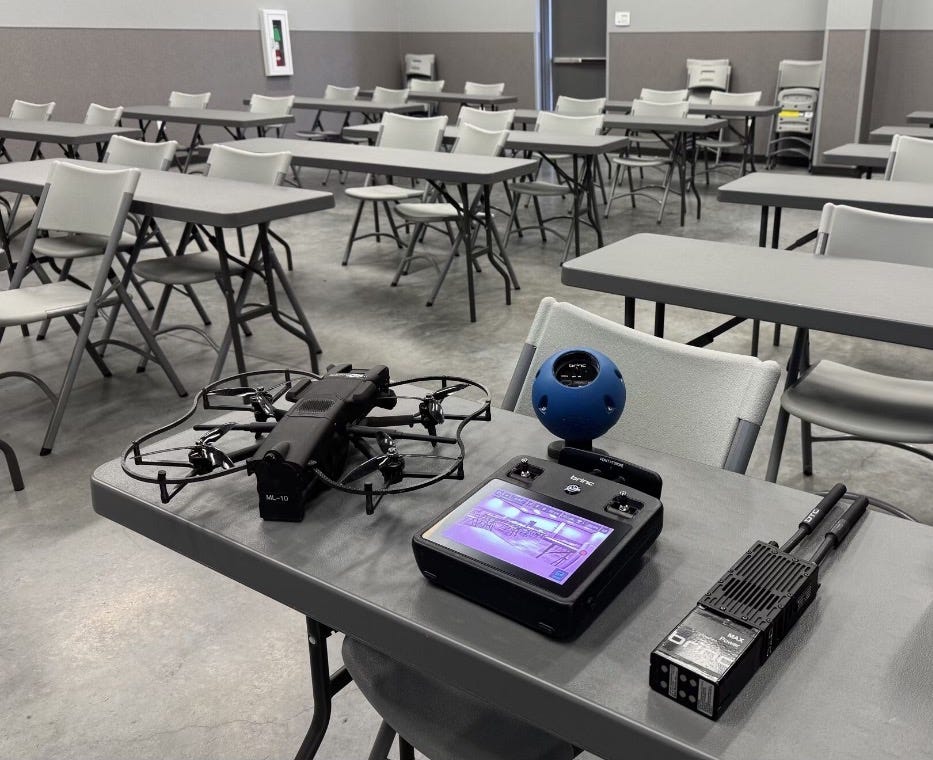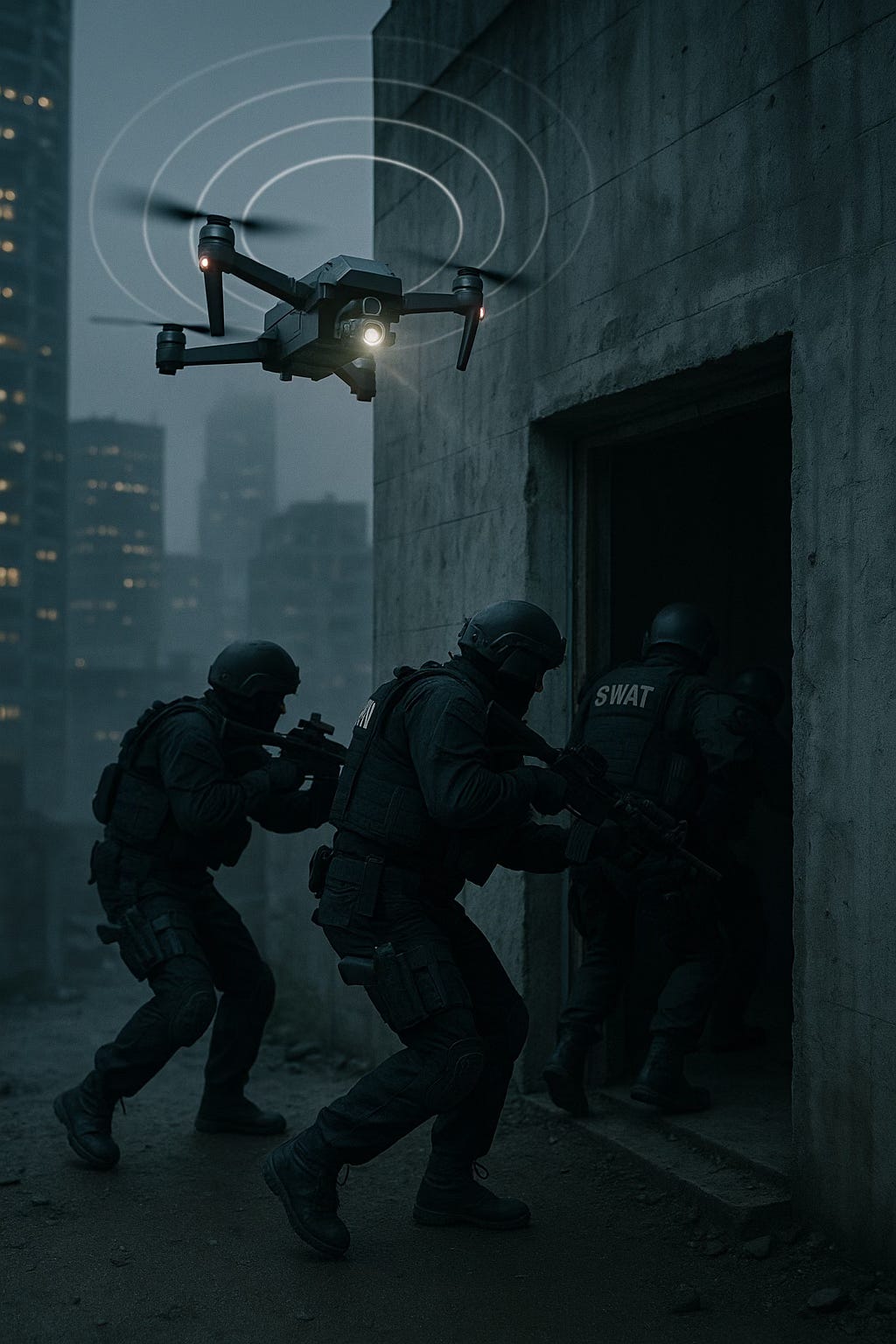Sworn to National Security, but Gaming the System?
A closer look at BRINC’s conduct at the LEDA UAS Conference raises questions about ethics, transparency, and readiness in the face of global drone competition.

BRINC Repeater Deployment at LEDA Training Event Raises Transparency Concerns
Undisclosed Equipment Sparks Allegations of Misconduct
In February 2025, law enforcement agencies from across the country gathered in Houston, Texas, for the LEDA UAS Super Regional Conference—a premier training event hosted by the Pearland Police Department and organized by the Law Enforcement Drone Association (LEDA). The goal: train officers in tactical drone operations and evaluate the latest UAS platforms under stress-tested, real-world conditions.
According to an insider familiar with the event, Mark Lang, a representative from BRINC Drones, placed undisclosed Lemur 2 repeaters inside a scenario house used during tactical flight simulations—a fact BRINC later acknowledged as a failure in communication and transparency. The source claimed this action may have been intended to artificially enhance the drone's performance before law enforcement evaluators.
“Their transmission system is subpar and cannot compete with non-American consumer products,” the source told The Zero Lux. “Hiding the device in a simulated SWAT scenario was presumably to convince pilots that their product was comparable. It didn’t work. The consumer platforms still outperformed the BRINC Lemur 2.”
Employee Conduct and Company Response
In an exclusive interview, David Benowitz, BRINC's Director of Strategy, Marketing, and Communications, acknowledged the incident. “Our team member, Mark did put repeaters in the building. He didn't communicate it properly to the team that was on site, which is not our standard operating procedure,” Benowitz said. “Not communicating it is slightly dishonest, and not what we like to do.”
He added that BRINC aims to be transparent about the advantages of its repeater-enabled mesh system, calling the lack of disclosure “a salesperson [who] blew a demo,” and emphasized that it “doesn’t represent” the company.
LEDA Standards and Scenario Integrity
While the 2024 LEDA Tactical Operations Standard does not explicitly mention vendor oversight, its emphasis on realistic scenario-based training, clear mission planning, and equipment transparency suggests that all tools used in evaluations should be known to and coordinated with training staff. In Section 6, LEDA outlines expectations that training scenarios mirror real-world constraints and include clearly defined operational goals, airspace permissions, and communication protocols — leaving little room for uncoordinated equipment use.
The 2024 standard does not include any formal disqualification protocol tied to concealed equipment. However, it does emphasize that UAS operations must be transparent, controlled, and consistent with FAA regulations, including signal integrity and safe launch-site practices. The use of unauthorized or undisclosed devices, such as signal boosters, could conflict with LEDA’s defined communication and airspace protocols — particularly those outlined in Sections 5 and 7.

BRINC’s explanation for repeater use centers on tactical flexibility in real-world deployments, such as signal reinforcement in concrete-heavy buildings or during SWAT callouts. Benowitz explained that BRINC drones are capable of creating mesh networks by combining airframes, controllers, and mounted repeaters to maintain signal in degraded RF environments. However, a DFR officer who spoke to The Zero Lux disputed this, stating, "Sounds unrealistic. If they're going in, they're going in. LEDA-NTOA Tactical Standard says to introduce tech if available, not enter to place tech."
Product Performance and Disputed Claims
When questioned about BRINC's reliability compared to other platforms, Benowitz stated: “We've had a lot of real-world situations where our products outperform competitors, whether it be American made or Chinese made. We're pretty confident in our connectivity performance. No connectivity solution is perfect in all these scenarios, so we built in flexibility.”
Benowitz added, “The entire U.S. industry is catching up to the foreign adversaries when it comes down to drone technology and capabilities… Lemur 2 makes leaps and bounds over Lemur S and is adding a lot more flexibility to its capabilities that gives it irreversibility in a tactical scenario than you would with a generic drone.”
He acknowledged BRINC's progress in signal stability: “We've improved performance significantly, generation over generation.” He also emphasized a broader challenge: “Connectivity is a problem for drones, period… Having flexibility is something critical to our customers.”
Despite BRINC's confidence in its performance, multiple DFR (Drone as First Responder) and SAR (Search and Rescue) professionals who spoke to The Zero Lux expressed concerns about the Lemur 2's signal strength and reliability in complex environments. Some confirmed that during the LEDA conference, consumer-grade drones like DJI's Avata 2 outperformed BRINC's platform in head-to-head evaluations—even without the use of hidden repeaters. It has also been confirmed that BRINC was aware the incident had occurred, which BRINC denies having any knowledge of. David Benowitz confirmed that BRINC did not attend the Utah LEDA Conference, dispelling speculation that the absence was tied to the Houston incident. According to Benowitz, the decision was due to a staffing shortage and unrelated to LEDA or the events in Houston.
Public Messaging vs. Closed-Door Practices
The LEDA Super Regional Conference is intended to offer agencies a neutral setting to evaluate drone systems side by side. BRINC confirmed its participation via Facebook, writing: “BRINC is proud to participate in the LEDA Houston 2025 Super Regional. Join us at this immersive training event…”
Despite that messaging, the undisclosed repeater incident raises questions about consistency between BRINC’s public image and its conduct in closed-door environments. The company has positioned itself as a secure, American alternative to Chinese-made drones and has publicly advocated for transparency and trust in public safety.
When asked how this aligns with BRINC’s values, Benowitz responded: “This isn’t a very well-known issue within the company… I was not aware of this until Friday, to be completely transparent.”
A Test of Credibility in a Competitive Market
As domestic drone manufacturers compete for agency contracts and trust, the handling of incidents like this becomes critical. BRINC has taken responsibility for the lack of disclosure, with Benowitz calling it “slightly dishonest” and confirming that it “is not our standard operating procedure.”
This transparency from BRINC may help mitigate concerns, but it does not erase the importance of adhering to established third-party protocols like those outlined by LEDA. In a competitive market where trust and mission-critical reliability matter, BRINC’s future credibility will depend not only on technical innovation—but also on how consistently it aligns real-world conduct with its public mission.
“Us being American made, you being able to get me on the phone, shows that we're significantly more transparent than a lot of our competitors in this space,” says David Benowitz, BRINC's Director of Strategy, Marketing, and Communications.



